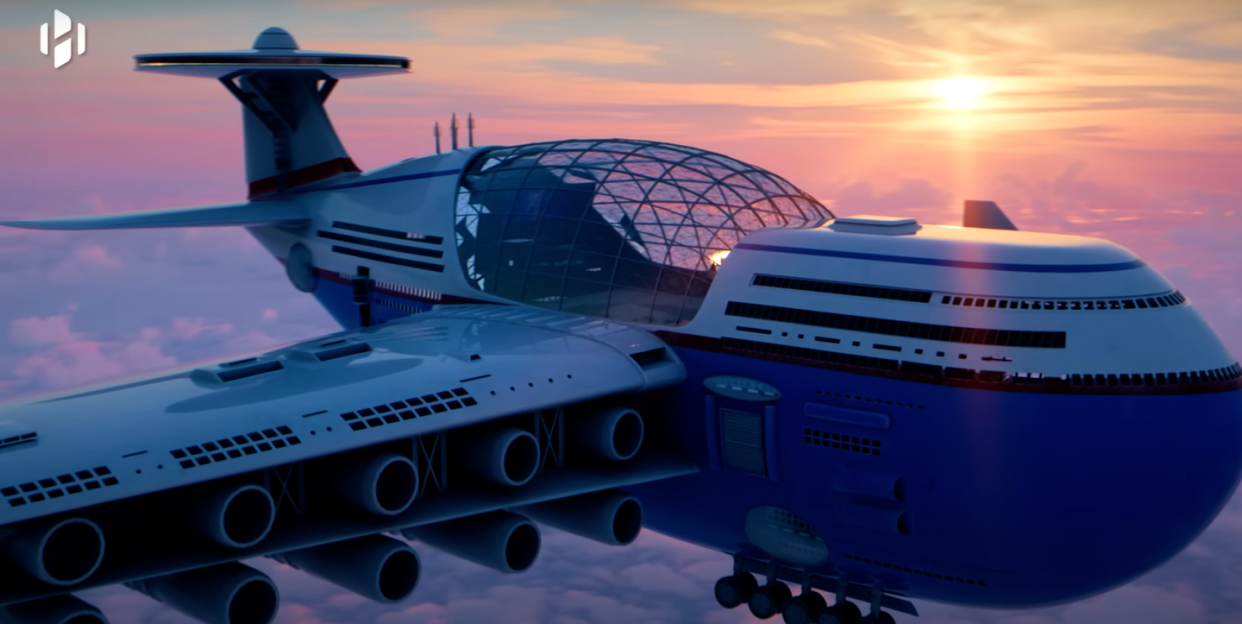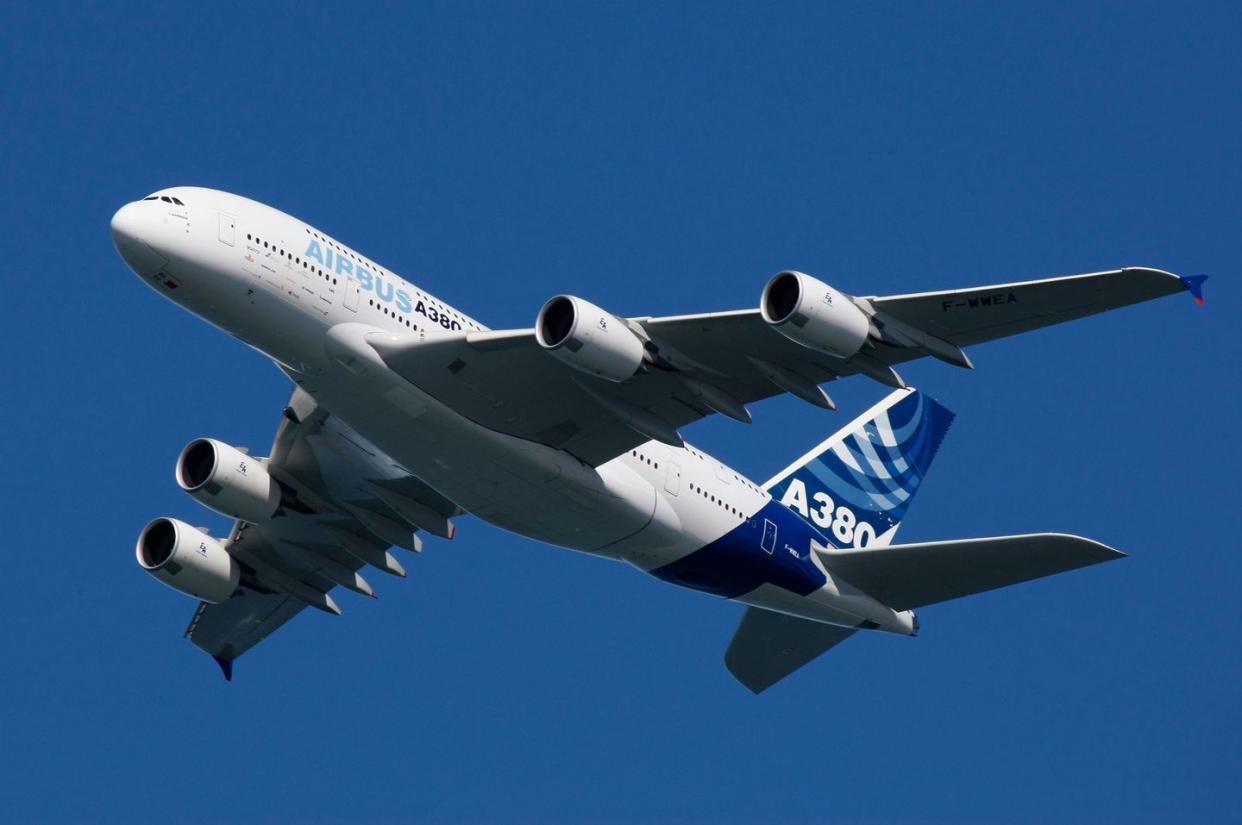Why This Viral Nuclear-Powered Flying Hotel Is Pure Science Fiction

A concept for a nuclear-powered flying hotel is designed to stoke optimism and ingenuity.
Nuclear fusion has become a touchstone for handwaving impossible technologies.
Just 5,000 people and their basic necessities of food and water weigh more than the largest planes today.
A concept for an enormous, nuclear airplane hotel took the internet by storm late last month. Sky Cruise picks up the legacy of science fictions so old they predate the genre’s name by a century or more, promising to carry 5,000 people for years at a time while running on nuclear fusion energy. But is this outlandish “Skytanic” even in the realm of possibility?
There are some elephants in the room from the very start. We aren’t all that close to nuclear fusion energy even in enormous, dedicated facilities on the ground. The earliest estimates for net-positive fusion are in the 2030s, and it’s honestly not clear yet that it will happen. So that’s an enormous hurdle before anything like Sky Cruise could ever, well, take off. (No offense to Sky Cruise, either; nuclear fusion is used as the “X factor” in a lot of outlandish ideas because it’s been popularized as a form of so-called unlimited energy.)
The largest existing passenger aircraft is the Airbus A380 800, which can hold up to 853 passengers. It’s been manufactured since 2005 and can travel nearly 9,500 miles at a time, almost 40 percent of Earth’s circumference. Aerotime reports that there were 242 of these planes making up to 330 flights a day at their peak.
But Sky Cruise creates an entirely new category. With up to 5,000 passengers, it’s large enough for other commercial aircraft to come and go in order to restock supplies and ferry passengers to and from the ground. It’s truly more like a flying town: 84 percent of the incorporated places in the U.S. have fewer than 10,000 people, according to Statista, a German market research company. My entire hometown would fit one-and-a-third times into the Sky Cruise. It’s more on par with the cruise ships that inspired it, which top out at about 5,500 passengers.
Those cruise ships weigh upward of 225,000 tons, though. The Airbus A380 800 has a maximum takeoff weight of just 650 tons, meaning even if we multiply out to a capacity of 5,000 passengers, that’s just 3,810 tons. The cruise ship would need to reduce weight by a factor of nearly 60 to compete in the air, or something spectacular would need to happen for an aircraft to support into at least the tens of thousands of tons. Aircraft at present are so vulnerable to the idea of excess weight that it has hindered any development of electric aircraft over a certain size because of the weight of the batteries alone.
The weight of 5,000 passengers, alone, at an average weight of 175 pounds, is nearly 440 tons. And let’s consider the weight of some of the items that 5,000 passengers will need. The average person needs at least four cups of water or other beverages a day. For 5,000 people, a month’s supply of just drinking water at a bare minimum rate of four cups per day—excluding bathing, cooking, and so on—is at least 156 tons. Most people are accustomed to drinking a lot more water than that. They’re also used to bathing regularly, brushing their teeth, boiling pasta, and so on.

If all the people aboard were surviving on just 2,000 calories of rice every day, the dry rice alone for a month would weigh 91 tons. The human bodies, minimum drinking water, and dry rice alone would already weigh more than the existing maximum take-off weight for the largest-ever traditional airplane. Even with nuclear fusion-powered engines to keep the plane at cruising altitude for years at a time, it’s hard to imagine how this plane will take off in the first place. The length of runway jumps from at least 6,000 feet for consumer aircraft below 100 tons to 13,000 feet for larger planes like the Boeing 747, and those top out at under 500 tons. Does this number double so regularly? Sky Cruise may need to take off from a U.S. interstate highway, or have a miles-long version of the slingshot used on aircraft carriers.
Would it have to be a vertical take-off vehicle, like a spacecraft launch? That’s no more outrageous than anything else about the concept; there are even existing ideas for how nuclear fusion might be harnessed to launch spacecraft. But the public and the scientific community are somewhat shy about discussing nuclear-powered launches because of the perceived risks of using this technology in a sort of freeform way on Earth’s surface. It’s challenging to imagine launching a nuclear-powered craft that will protect everyone and everything aboard from radiation and also not harm the ground crew.
Nuclear fusion devices occupy an interesting catch-22 in the public imagination because they’re touted as so plentiful as to be virtually infinite, meaning even the enormous weight of a 5,000-passenger Sky Cruise is considered negligible. After all, as we learn in calculus, any concrete number that faces infinity functionally reduces to zero. But Sky Cruise runs on 20 fusion reactors, where each one likely weighs many tons.
The world’s largest tokamak fusion reactor in the works, ITER in France, will weigh 23,000 tons. Even its individual components are so heavy that they require a specially-built access road to the facility after shipping in from overseas. ITER is considered oversize—an enormous, internationally cooperative, and symbolic prototype that will prove the technology is viable—but all nuclear fusion reactors have to deal with certain facts of life. They work by containing a quantity of elemental plasma that is millions of degrees hot. That usually requires not just a huge vessel, but an even huger surrounding vessel that holds supercooling mechanisms to keep the magnets and materials in the right zone to function and not melt down.
But the race to cross the nuclear fusion finish line is running in tandem with some other exciting research in materials, especially superconductors. One big push is for so-called “high temperature” (meaning, just not at nearly absolute zero) or even “room temperature” superconducting materials, something that would mean a lot less superstructure surrounding the magnets that help to shape tokamak reactor plasma.
The Sky Cruise concept is outlandish at best, but you may find it inspiring: something that technology could eventually deliver to us that would potentially fill a need in the marketplace of ideas. And while that’s cool on its own, this fusion-powered aircraft could point toward something that’s more realistic in the near future, which is a regular passenger plane powered by some kind of nuclear reactor. If large airliners can’t support electric batteries, this may be something they could do instead, along with other concepts like hydrogen. Only time will tell.
You Might Also Like
